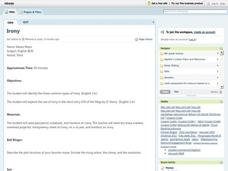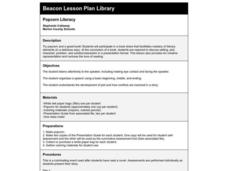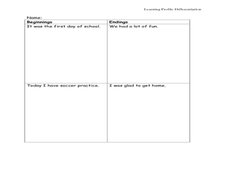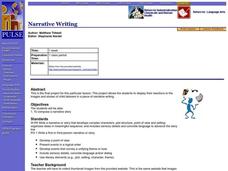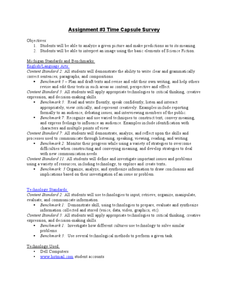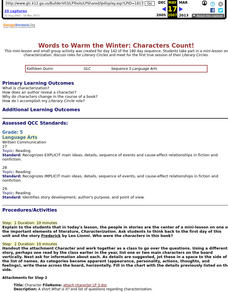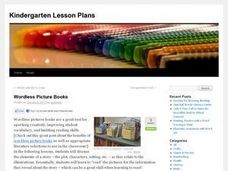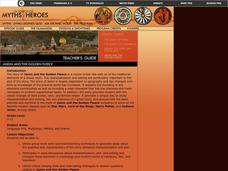Curated OER
Irony
What are the three types of irony? High schoolers engage in a lesson about the use of irony while reading O.Henry's short story "Gift of the Magi." They'll discuss rising action, climax, and resolution in the text before highlighting the...
Marion County Schools
Popcorn Literacy
Popcorn is a tasty part of a culminating activity designed to motivate readers to share important literary elements. The popcorn fills the inside of a white paper bag that is transformed on the outside into a presentation tool with the...
Curated OER
Literary Analysis of The Minister's Black Veil
After reading The Minister's Black Veil, by Nathaniel Hawthorne as a homework assignment your class will complete a literary analysis. Learners will analyze important element of the story and take notes to help support their...
Curated OER
Drama/Theatre
Students discover how setting, props, and character-action communicate information about the characters and the story. Access to videos and a video camera are important to make this lesson a success.
Pyro Innovations
Reading Comprehension
Good reading practices can start at any age. Early readers work with the teacher to read a short story about a bear. First, they identify basic text features, such as the title, author, and illustrator. Then, they answer several simple...
Curated OER
The Lion, the Witch and The Wardrobe: Literature and Theater
Students read and discuss the literary elements of "The Lion, the Witch and the Wardrobe" by C.S. Lewis. They explore the elements of dramatic performance and create a TV news program based on life in Narnia. They videotape their...
Curated OER
Harmony and Expression in Writing Form
How do you write an interesting beginning, middle, and end of a story? With this lesson, young writers look to other stories as examples. Then, they use some of the attached graphic organizers to help them create their own story. Note:...
Shmoop
ELA.CCSS.ELA-Literacy.RL.11-12.2
There is nothing more frustrating than discussing theme in literature, and now the Common Core requires that your learners determine two or more, and discuss the development of it throughout the text. This is crazy, but manageable with...
Curated OER
Narrative Writing
Imagine a day in the life of a child who has to work 12-14 hours a day, seven days a week. After viewing images and reading stories of child laborers, class members select an image and write a richly detailed narrative about a typical...
Teaching English
Fairy Tales; Not Just for Kids
"Once upon a time . . ." Language learners examine the key elements of well-known fairy tales and then craft their own.
Curated OER
So Foul and Fair a Play
Students watch various interpretations of Shakespeare's Macbeth in film. In groups, they examine the setting, characters, music and sequence. They compare and contrast the various films and discuss the differences. They write an essay on...
Curated OER
Against the Odds
What factors help people achieve goals? What factors prevent people from achieving goals? What are the elements that need to be in place to make a team function well? Using Damien Lewis’ Desert Claw and John Francome’s Winner Takes All,...
Curated OER
Time Capsule Survey
Here's a fun way to incorporate technology into your curriculum. E-mail each of your class members a picture and 10 questions about the photo. Individuals then imagine the story behind the image and e-mail back their responses. Although...
Curated OER
Greeting Card to A Character
Students create a greeting card from one character to another after finishing a novel. Individually, they use their imagination to write the paragraph using the text to support their ideas. They share their greeting card with the class...
Curated OER
Deciding Theme
Fifth graders explore the theme of a story by identifying the effects of a character's decision. In this theme study instructional activity, 5th graders refer to the events in The Lion, The Witch and the Wardrobe. Students discuss as a...
Curated OER
Character Development-Nanavi, A Girl from Benin, West Africa
Students examine the ways a character changes throughout the course of a story. In this literary analysis activity, students discuss a story that spans three years in a young girl's life. Students analyze the changes the girl...
Curated OER
Evaluate Problem-Solving in the Context of Culture and Time-frame
Students examine literary elements in non-fiction literature. In this problem solving lesson, students read Rosa Parks, My Story and Beyond the Limits. Students make oral presentations based on the causes and effects, conflicts, and...
Curated OER
Finding Buck Henry
Students read and demonstrate competence in the general skills and strategies of the writing process via the novel "Finding Buck Henry." They recognize complex elements of plot. Students analyze devices used to develop characters in...
Curated OER
Words to Warm the Winter: Characters Count!
Fifth graders take part in a mini-lesson on characterization, discuss roles for Literary Circles and meet for the first true session of their Literary Circles.
Curated OER
Wordless Picture Books
Students use wordless picture books to examine elements regarding a story, the plot, and characters. In this wordless picture books lesson, students select a book to creatively discuss. Students then listen to the teacher read the story...
Curated OER
Aztec Myths 1
Students write a diary entry or a letter from the viewpoint of a character in a myth. For this Aztec myths lesson, students define myths and read "The Heart of Copil" and "The Eagle of Tenochtitlan" and find the land of the...
Curated OER
Jason and the Golden Fleece
Young scholars read and analyze the classic Greek tale of "Jason and the Golden Fleece." They compare/contrast the story with modern works of literature and films, answer discussion questions, and retell the story in a modern-day setting.
Curated OER
Cinderella Is A Fella
Second graders identify the universal theme in the Cinderella story. In this fairy tale lesson, 2nd graders develop their vocabularies as they read a variation of Cinderella.
Curated OER
Creating Comic Strips
Students recognize the elements needed to create a comic strip. In this comic strip instructional activity, student understand that comic strips need words and pictures. Students find differences and similarities in comic strips....
